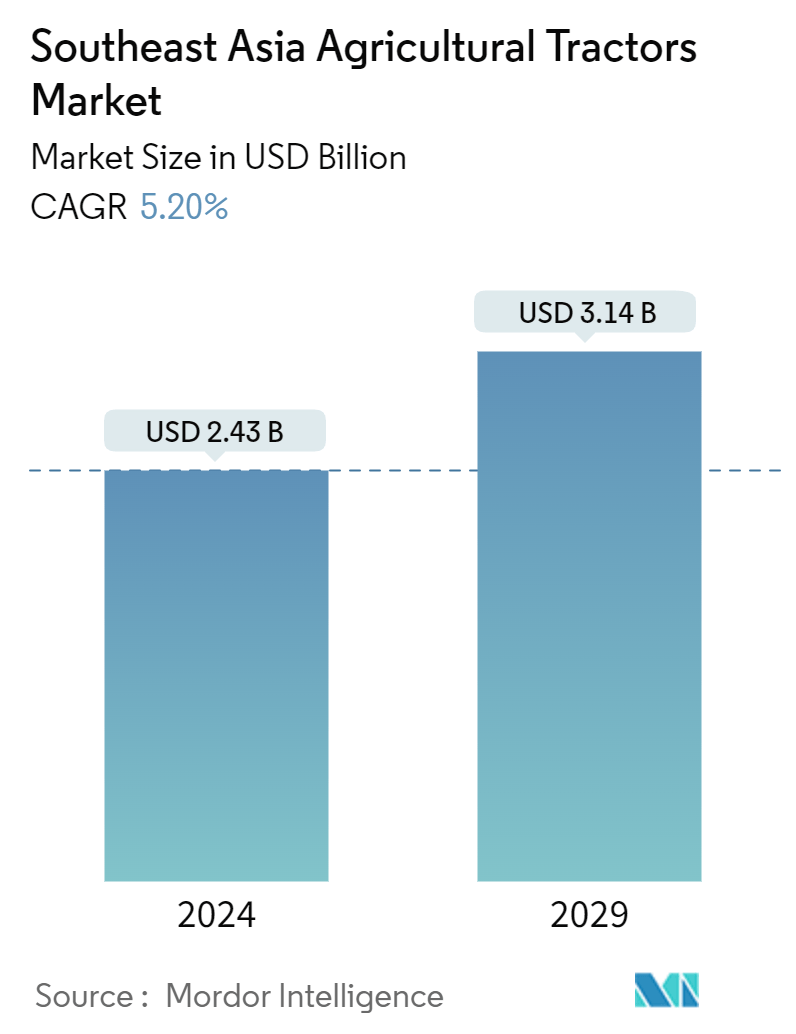Market Size of Southeast Asia Agricultural Tractors Industry

| Study Period | 2019 - 2029 |
| Base Year For Estimation | 2023 |
| Market Size (2024) | USD 2.43 Billion |
| Market Size (2029) | USD 3.14 Billion |
| CAGR (2024 - 2029) | 5.20 % |
| Market Concentration | High |
Major Players.webp)
*Disclaimer: Major Players sorted in no particular order |
Southeast Asia Agriculture Tractors Market Analysis
The Southeast Asia Agricultural Tractors Market size is estimated at USD 2.43 billion in 2024, and is expected to reach USD 3.14 billion by 2029, growing at a CAGR of 5.20% during the forecast period (2024-2029).
The increasing unavailability of skilled farm laborers, growing mechanization of agriculture, and demand for various tractors with different horsepower are boosting the sales of agriculture tractors in Southeast Asia. Farmers are increasingly adopting agricultural mechanization as a substitute for manual labor. Among Southeast Asian countries, agriculture tractors were widely used in Vietnam. In developing countries of the region, the demand for lower HP tractors is high due to the low disposable income of farmers and high labor costs. Farmers prefer small and customized tractors for agricultural purposes due to small farmland sizes. Moreover, less fuel consumption by small tractors helps to empower small and marginal farmers. Increasing demands for power, precision, handling, and efficiency have shaped the development of modern tractors and continue to drive their growth during the forecast period. Increasing farm mechanization in developing countries fortifies the demand and production of agricultural tractors. However, repair and maintenance expenses are also expanding, which acts as a restraint to the market.
Southeast Asia Agriculture Tractors Industry Segmentation
An agricultural tractor is a vehicle designed to deliver a high tractive effort at slow speeds to haul a trailer or machinery. The market does not cover other agricultural machinery and attachments to the tractor. The tractor used for industrial and construction purposes is also excluded from the study.
The Southeast Asia agricultural tractor market is segmented by type (orchard tractors, row-crop tractors, and utility tractors), horsepower (less than 12 HP, 12 HP to 99 HP, 100 HP to 175 HP, and Above 175 HP), and geography (Thailand, Vietnam, Malaysia, Indonesia, Singapore, Philippines, Cambodia, Myanmar, and Rest of Southeast Asia).
The market sizing has been done in value terms in USD for all the abovementioned segments.
| Type | |
| Orchard Tractors | |
| Row-Crop Tractors | |
| Utility Tractors |
| Horse Power | |
| Less than 12 HP | |
| 12 HP to 99 HP | |
| 100 HP to 175 HP | |
| Above 175 HP |
| Geography | |
| Thailand | |
| Vietnam | |
| Malaysia | |
| Indonesia | |
| Singapore | |
| Philippines | |
| Cambodia | |
| Myanmar | |
| Rest of Southeast Asia |
Southeast Asia Agricultural Tractors Market Size Summary
The Southeast Asia agricultural tractors market is experiencing significant growth, driven by factors such as the increasing mechanization of agriculture and the rising demand for tractors with varying horsepower. The region's farmers are increasingly turning to mechanization as a substitute for manual labor, particularly in countries like Vietnam, where tractor usage is prevalent. The demand for lower horsepower tractors is particularly high in developing countries within the region, due to the low disposable income of farmers and high labor costs. Small and customized tractors are preferred due to the smaller size of farmlands, and their lower fuel consumption benefits small and marginal farmers. The market is further propelled by the need for power, precision, handling, and efficiency in modern tractors, although rising repair and maintenance costs pose challenges.
Government initiatives in countries like Thailand are also playing a crucial role in promoting the mechanization and modernization of agriculture. Programs such as the Thailand 20-Year Strategic Plan and Thailand 4.0 for Smart Farmers aim to enhance farmer welfare and boost the agricultural machinery market. These efforts are driven by the need to address food security concerns due to rapid population growth, prompting increased tractor demand to enhance production and yield. The market is consolidated, with major players like Deere & Company, Kubota Corporation, and CNH Industrial NV leading the way through strategic partnerships and product launches. Innovations such as John Deere's autonomy-ready tractors and Kubota's electric and autonomous tractors highlight the industry's focus on sustainability and efficiency.
Southeast Asia Agricultural Tractors Market Size - Table of Contents
-
1. MARKET DYNAMICS
-
1.1 Market Overview
-
1.2 Market Drivers
-
1.2.1 Skilled Labor Shortage
-
1.2.2 Favorable Government Policies
-
-
1.3 Market Restraints
-
1.3.1 Fragmentation of Land Holdings
-
1.3.2 Increasing Interest of Farmers Toward Custom Hiring Center
-
-
1.4 Porter's Five Forces Analysis
-
1.4.1 Bargaining Power of Suppliers
-
1.4.2 Bargaining Power of Buyers/Consumers
-
1.4.3 Threat of New Entrants
-
1.4.4 Threat of Substitute Products
-
1.4.5 Intensity of Competitive Rivalry
-
-
-
2. MARKET SEGMENTATION
-
2.1 Type
-
2.1.1 Orchard Tractors
-
2.1.2 Row-Crop Tractors
-
2.1.3 Utility Tractors
-
-
2.2 Horse Power
-
2.2.1 Less than 12 HP
-
2.2.2 12 HP to 99 HP
-
2.2.3 100 HP to 175 HP
-
2.2.4 Above 175 HP
-
-
2.3 Geography
-
2.3.1 Thailand
-
2.3.2 Vietnam
-
2.3.3 Malaysia
-
2.3.4 Indonesia
-
2.3.5 Singapore
-
2.3.6 Philippines
-
2.3.7 Cambodia
-
2.3.8 Myanmar
-
2.3.9 Rest of Southeast Asia
-
-
Southeast Asia Agricultural Tractors Market Size FAQs
How big is the Southeast Asia Agricultural Tractors Market?
The Southeast Asia Agricultural Tractors Market size is expected to reach USD 2.43 billion in 2024 and grow at a CAGR of 5.20% to reach USD 3.14 billion by 2029.
What is the current Southeast Asia Agricultural Tractors Market size?
In 2024, the Southeast Asia Agricultural Tractors Market size is expected to reach USD 2.43 billion.

